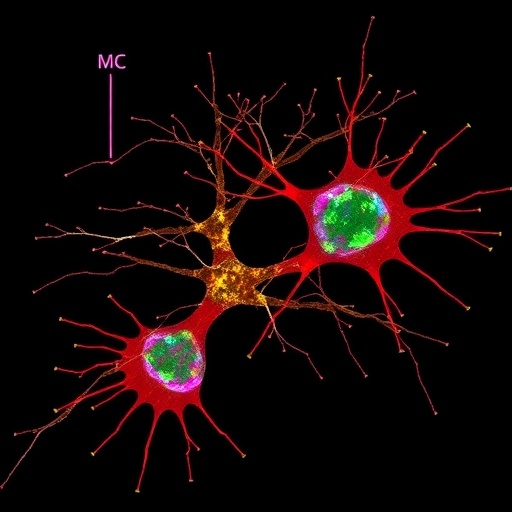In a groundbreaking study led by researchers at The University of Osaka in collaboration with the Massachusetts Institute of Technology, new molecular insights have been revealed regarding chromosome alignment during cell division, a fundamental process critical for maintaining genomic stability. The study unveils a cooperative mechanism between two motor proteins, KIF18A and CENP-E, which work intricately downstream of the kinetochore protein CENP-C to ensure proper chromosome congression. This discovery not only deepens our understanding of mitotic chromosome behavior but also highlights a novel therapeutic strategy targeting cancer cells.
Proper chromosome segregation during mitosis is essential for accurate cell proliferation. Errors in this process often result in chromosomal instability, a hallmark of many cancers that fuels tumor progression and resistance to treatments. Central to this segregation process is the kinetochore, a multi-protein complex assembled on the centromere of each chromosome, which serves as the attachment site for spindle microtubules, facilitating chromosome movement. Deciphering the molecular interactions that govern kinetochore function has been challenging due to the redundancy and overlap among numerous involved proteins.
Employing a genome-wide CRISPR-Cas9 screening approach, the researchers focused on cells harboring a mild mutation in the CENP-C gene, which encodes an essential kinetochore protein responsible for recruiting other kinetochore components. The screen identified KIF18A, a kinesin family motor protein, as a synthetic lethal partner to the CENP-C mutation. Loss of KIF18A function in this compromised cellular context led to lethality, indicating a previously unappreciated genetic interaction critical for cell viability under kinetochore stress.
Further mechanistic investigations revealed that the CENP-C mutation indirectly caused a reduction in CENP-E activity, another motor protein at the kinetochore involved in guiding chromosome movement. Importantly, KIF18A and CENP-E were shown to act cooperatively to facilitate the congression of chromosomes to the metaphase plate, a crucial step ensuring that chromosomes are aligned before segregation. Each motor can partially compensate for the other; however, their simultaneous inhibition results in catastrophic failure of chromosome alignment.
This cooperative motor activity is of particular relevance in the context of cancer biology. Certain cancer cell lines were identified to naturally express low levels of CENP-E, rendering them especially vulnerable to KIF18A inhibition. The study demonstrated that targeting KIF18A in these cancer cells triggered selective cell death, exploiting a synthetic lethality that spares normal cells with intact CENP-E function. This selective vulnerability offers a promising therapeutic window to develop targeted cancer treatments with reduced off-target toxicity.
The research team leveraged a cell model with a partially defective kinetochore apparatus to uncover these vulnerabilities, exemplifying the power of combining genetic perturbations with high-throughput screening technologies to dissect complex cellular processes. The finding that KIF18A and CENP-E act downstream of CENP-C integrates prior knowledge of kinetochore assembly with functional motor cooperation, revealing the layered regulation required for mitotic fidelity.
At the molecular level, KIF18A and CENP-E serve distinct yet overlapping functions in chromosome movement. KIF18A primarily regulates microtubule dynamics and dampens chromosome oscillations, while CENP-E drives poleward movement of chromosomes along spindle microtubules. Their joint activity orchestrates the precise spatial positioning of chromosomes, facilitating proper microtubule attachments and checkpoint satisfaction, thus ensuring reliable chromosome segregation.
Cancer cells often harbor deregulated mitotic machinery, and this study underscores how subtle variations in motor protein expression can be exploited for therapeutic purposes. By quantifying CENP-E protein levels, clinicians might identify tumors predisposed to respond favorably to KIF18A-targeted therapies. Furthermore, the prospect of combination treatments inhibiting both motors could potentiate efficacy, potentially circumventing resistance mechanisms common in monotherapies.
Beyond immediate therapeutic implications, this work exemplifies the critical need for molecular-level investigations to illuminate novel cancer vulnerabilities. Professor Tatsuo Fukagawa, the senior author, emphasizes that translating basic mitotic biology into clinical strategies mandates a foundational understanding of the cellular machinery, as demonstrated in this elegant work that links motor protein cooperation to selective cancer cell killing.
The implications of this study extend to understanding the broader landscape of kinetochore function in health and disease. It encourages further exploration of mitotic motor redundancies as pharmacological targets, a frontier that may yield increasingly refined cancer therapies. Given the essential role of chromosome alignment in genomic stability, dissecting these redundancies may also uncover reasons behind tumor heterogeneity and differential drug susceptibilities.
Moreover, the synthetic lethality observed with impaired KIF18A and CENP-E activity presents a conceptual advance for cancer treatment design, harnessing specific genetic and proteomic contexts of tumor cells to achieve selective eradication. This precision strategy aligns with contemporary trends aiming to shift from broad-spectrum cytotoxic agents to targeted molecular interventions.
In conclusion, the study published in Cell Reports on November 10, 2025, heralds a new understanding of mitotic regulation through the cooperative actions of KIF18A and CENP-E motor proteins downstream of CENP-C. This discovery opens innovative avenues for cancer therapy by exploiting inherent weaknesses in cancer cells while preserving normal cell function. The collaboration between The University of Osaka and MIT demonstrates how cutting-edge molecular biology, genomics, and cancer research converge to produce clinically translatable knowledge.
Subject of Research: Cells
Article Title: KIF18A promotes chromosome congression in cooperation with CENP-E downstream of CENP-C
News Publication Date: 10-Nov-2025
References: 10.1016/j.celrep.2025.116515
Image Credits: Original content by Tatsuo Fukagawa
Keywords: Life sciences, Health and medicine, Cell biology, Molecular biology, Cancer cells, Centromeres, Kinetochores
Tags: cancer cell treatment strategieschromosomal instability in tumorschromosome alignment during cell divisionCRISPR/Cas9 genome screeningdual inhibition of motor proteinsgenomic stability in cancerKIF18A and CENP-E interactionkinetochore protein functionmitotic chromosome behaviormolecular mechanisms of mitosisspindle microtubule attachmenttherapeutic strategies for cancer





